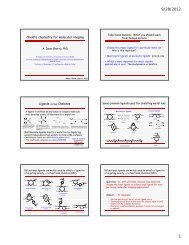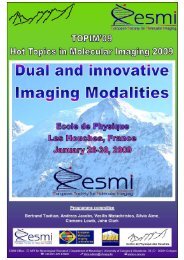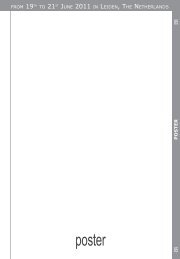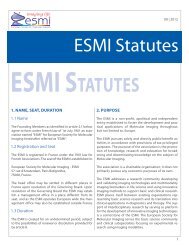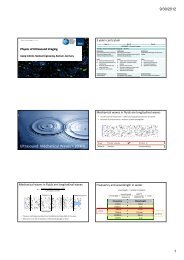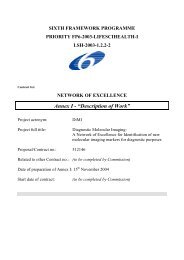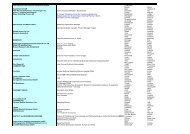5th EuropEan MolEcular IMagIng MEEtIng - ESMI
5th EuropEan MolEcular IMagIng MEEtIng - ESMI
5th EuropEan MolEcular IMagIng MEEtIng - ESMI
You also want an ePaper? Increase the reach of your titles
YUMPU automatically turns print PDFs into web optimized ePapers that Google loves.
60<br />
WarSaW, poland May 26 – 29, 2010<br />
Chairman of section of Molecular Cytology, Director Centre for Advanced Microscopy<br />
Swammerdam Institute for Life Sciences, University of Amsterdam, The Netherlands<br />
www.mc.bio.uva.nl<br />
Dr. Gadella is founder/director of the Centre for Advanced Microscopy (CAM) at the University of Amsterdam<br />
and full professor in Molecular Cytology chairing a group of 25-30 scientists including 4 assistant<br />
professors. The CAM and chairgroup are positioned within the Swammerdam Institute for Life Science at<br />
the Science Faculty of the University of Amsterdam and fully integrated within the Netherlands Institute for<br />
Systems Biology founded in 2007. Dr Gadella personally supervises a research team on spatiotemporal cell<br />
signaling. His team wants to understand how cells can achieve and maintain a local signal in order to drive<br />
morphogenesis, to define new cytoskeletal anchorage or vesicle-docking sites. The focus is on signal flow<br />
across and in the plane of the membrane of living mammalian cells. To this end genetic encoded fluorescent<br />
biosensors are employed and the in situ molecular interactions between signaling molecules including phospholipid-second<br />
messengers, receptors, G-proteins and downstream targets are analyzed. By multiparameter<br />
imaging approaches several signaling events are visualized and quantified simultaneously in individual living<br />
cells with sub-second temporal and submicron spatial resolution. The in situ cellular imaging research<br />
heavily depends on advanced bioimaging. To this end advanced automated microscopy approaches such<br />
as fluorescence resonance energy transfer (FRET) microscopy (including bleaching-, spectral-, ratio- and<br />
fluorescence lifetime-imaging approaches), fast live cell microscopy (including spinning disk, line-scanning<br />
and controlled light exposure confocal microscopy, and total internal reflection microscopy (TIRF)), and<br />
photochemical microscopy approaches such as photoactivation, uncaging, fluorescence recovery after photobleaching<br />
(FRAP), fluorescence loss in photobleaching microscopy (FLIP), fluorescence correlation spectroscopy<br />
(FCS), cross-correlation (FCCS), lifetime-correlation (FCLS) have been implemented developed<br />
and applied to quantifying cell signalling phenomena. Currently, the palette of advanced imaging instrumentation<br />
is expanded with superresolution localization microscopy approaches such as PALM and STORM.<br />
The research group is funded from university resources (roughly 40%), national grant agencies (NWO-ALW,<br />
CW, FOM and STW) and several international grants (ESF and EU-FP6/7 projects including integrated projects,<br />
STREPs and TMR programs).<br />
The Gadella lab has numerous (inter)national collaborations in the field of signal transduction (Dr. C. Hoffman,<br />
Univ. Würzburg; M. Wymann, Univ. Basle; K. Jalink, NKI Amsterdam) and collaborations on probe<br />
development (dr. C. Schultz, EMBL Heidelberg; dr. K. Lukyanov & D. Chudakov, Moscow) and collaborations<br />
on advanced light microscopy (prof. van Noorden (AMC); dr. A. Houtsmuller, Erasmus MC; dr. H.<br />
Gerritsen, Utrecht; dr. Dobrucki, Univ. Krakow; prof. M. Carmo Fonseca, Lisbon). In 2007 prof Gadella<br />
was elected president of the Netherlands Society for Advanced Microscopy. Recently he was appointed as<br />
national coordinator of the advanced light microscopy activities of the Netherlands for the new large EU<br />
infrastructure (ESFRI) programme EuroBioimaging that recently entered the startup phase.<br />
imaging life<br />
Theodorus W.J. Gadella Jr.



